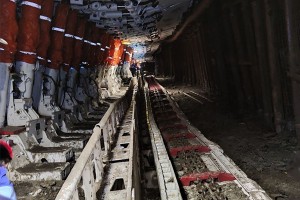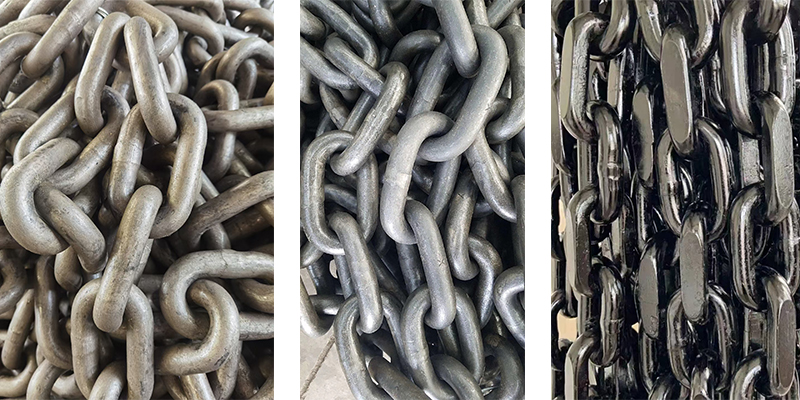
1. Story of round link chains for mining
With the increasing demand for coal energy in the world economy, coal mining machinery has developed rapidly. As the main equipment of comprehensive mechanized coal mining in coal mine, the transmission component on scraper conveyor has also developed rapidly. In a sense, the development of scraper conveyor depends on the development of mining high-strength round link chain. Mining high-strength round link chain is the key part of chain scraper conveyor in coal mine. Its quality and performance will directly affect the working efficiency of equipment and coal output of coal mine.
The development of mining high-strength round link chain mainly includes the following aspects: the development of steel for mining round link chain, the development of chain heat treatment technology, the optimization of round steel link chain size and shape, different chain design and the development of chain making technology. Due to these developments, the mechanical properties and reliability of mining round link chain have been greatly improved. The specifications and mechanical properties of chain produced by some advanced chain manufacturing enterprises in the world have far exceeded the German DIN 22252 standard widely used in the world.
The early low-grade steel for mining round link chain abroad was mostly carbon manganese steel, with low carbon content, low alloy element content, low hardenability, and chain diameter < ø 19mm. In the 1970s, manganese nickel chromium molybdenum series high-grade chain steels were developed. Typical steels include 23MnNiMoCr52, 23MnNiMoCr64, etc. these steels have good hardenability, weldability and strength and toughness, and are suitable for the production of large-scale C-grade chain. 23MnNiMoCr54 steel was developed in the late 1980s. Based on 23MnNiMoCr64 steel, the content of silicon and manganese was reduced and the content of chromium and molybdenum was increased. Its toughness was better than that of 23MnNiMoCr64 steel. In recent years, due to the continuous improvement of the performance requirements of round link steel chain and the continuous increase of chain specifications due to mechanized coal mining in coal mines, some chain companies have developed some special new steel grades, and some properties of these new steel grades are higher than 23MnNiMoCr54 steel. For example, the "HO" steel developed by German JDT company can increase the chain strength by 15% compared with 23MnNiMoCr54 steel.
2.Mining chain service conditions and failure analysis
2.1 mining chain service conditions
The service conditions of round link chain are: (1) tension force; (2) Fatigue caused by pulsating load; (3) Friction and wear occur between chain links, chain links and chain sprockets, and chain links and middle plates and groove sides; (4) Corrosion is caused by the action of pulverized coal, rock powder and humid air.
2.2 mining chain links failure analysis
The breaking forms of mining chain links can be roughly divided into: (1) the load of the chain exceeds its static breaking load, resulting in premature fracture. This fracture mostly occurs in the defective parts of the chain link shoulder or straight area, such as crack from flash butt welding heat affected zone and individual bar material crack; (2) After running for a period of time, the mining chain link has not reached the breaking load, resulting in the fracture caused by fatigue. This fracture mostly occurs at the connection between the straight arm and the crown of the chain link.
Requirements for mining round link chain: (1) to have high load bearing capacity under the same material and section; (2) to have higher breaking load and better elongation; (3) to have small deformation under the action of maximum loading capacity to ensure good meshing; (4) to have high fatigue strength; (5) to have high wear resistance; (6) to have high toughness and better absorption of impact load; (7) the geometric dimensions to meet the drawing.
3.Mining chain production process
Production process of mining chain: bar cutting → bending and knitting → joint → welding → primary proof test → heat treatment → secondary proof test → inspection. Welding and heat treatment are the key processes in the production of mining round link chain, which directly affect the product quality. Scientific welding parameters can improve the yield and reduce the production cost; appropriate heat treatment process can give full play to the material properties and improve the product quality.
In order to ensure the welding quality of mining chain, manual arc welding and resistance butt welding have been eliminated. Flash butt welding is widely used because of its outstanding advantages such as high degree of automation, low labor intensity and stable product quality.
At present, the heat treatment of mining round link chain generally adopts medium frequency induction heating, continuous quenching and tempering. The essence of medium frequency induction heating is that the molecular structure of the object is stirred under the electromagnetic field, the molecules obtain energy and collide to produce heat. During medium frequency induction heat treatment, the inductor is connected with medium frequency AC of a certain frequency, and the chain links moves at a uniform speed in the inductor. In this way, an induced current with the same frequency and opposite direction as the inductor will be generated in the chain links, so that the electric energy can be transformed into heat energy, and the chain links can be heated to the temperature required for quenching and tempering in a short time.
Medium frequency induction heating has fast speed and less oxidation. After quenching, very fine quenching structure and austenite grain size can be obtained, which improves the strength and toughness of the chain link. At the same time, it also has the advantages of cleanliness, sanitation, easy adjustment and high production efficiency. In the tempering stage, the chain link welding zone passes through a higher tempering temperature and eliminates a large amount of quenching internal stress in a short time, which has a very significant effect on improving the plasticity and toughness of the welding zone and delaying the initiation and development of cracks. The tempering temperature at the top of the chain link shoulder is low, and it has higher hardness after tempering, which is conducive to the wear of the chain link during the working process, i.e., the wear between the chain links and the meshing between chain links and the chain sprocket.
4. Conclusion
(1) The steel for mining high-strength round link chain is developing in the direction of higher strength, higher hardenability, higher plastic toughness and corrosion resistance than 23MnNiMoCr54 steel commonly used in the world. At present, new and patented steel grades have been applied.
(2) The improvement of mechanical properties of mining high-strength round link chain promotes the continuous improvement and perfection of heat treatment method. The reasonable application and accurate control of heat treatment technology is key to improve the mechanical properties of chain. Mining chain heat treatment technology has become the core technology of chain makers.
(3) The size, shape and chain structure of mining high-strength round link chain have been improved and optimized. These improvements and optimizations are made according to the results of chain stress analysis and under the condition that the power of coal mining equipment needs to be increased and the underground space of coal mine is limited.
(4) The increase of the specification of mining high-strength round link chain, the change of structural form and the improvement of mechanical properties promote the correspondingly rapid development of round steel link chain making equipment and technology.
Post time: Dec-22-2021






